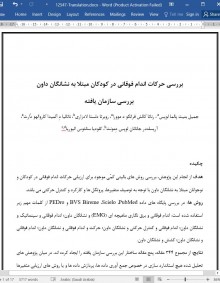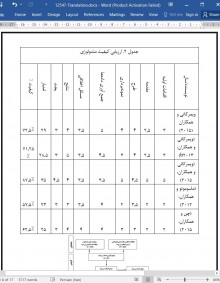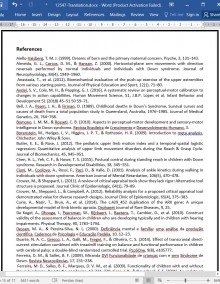
دانلود مقاله بررسی حرکات اندام فوقانی در کودکان مبتلا به نشانگان داون
چکیده
هدف از انجام این پژوهش، بررسی روش های بالینی کمّی موجود برای ارزیابی حرکات اندام فوقانی در کودکان و نوجوانان مبتلا به نشانگان داون با توجه به توصیف متغیرها، پروتکل ها و کارکرد و کنترل حرکتی می باشد.
روش ها: در بررسی پایگاه های داده PubMed، Scielo، BVS Bireme و PEDro از کلمات مهم زیر استفاده شده است: اندام فوقانی و برق نگاری ماهیچه ای (EMG) و نشانگان داون؛ اندام فوقانی و سینماتیک و نشانگان داون؛ اندام فوقانی و کنترل حرکتی و نشانگان داون؛ حرکت و اندام فوقانی و نشانگان داون؛ اندام فوقانی و نشانگان داون؛ کشش و نشانگان داون.
نتایج: از مجموع 344 مقاله، پنج مقاله ساختار این بررسی سازمان یافته را ایجاد کرده اند. در میان پژوهش های تحلیل شده هیچ استاندارد سازی در خصوص جمع آوری داده ها، پردازش داده ها و یا روش های ارزیابی متغیرها دیده نمی شود.
نتيجه گيري: ارزيابي سینماتیک براي مبحث نتایج مناسب است، اما تفاوت هاي متدولوژی در این پژوهش ها و نتايج غير متناقض، تأثیری منفی را بر تفاسیر بالینی و احتمال تکرارپذیری می گذارد. استاندارد سازی پروتکل ارزیابی حرکت اندام فوقانی با استفاده از تحلیل سینماتیک مهم است، زیرا این امر مبنایی برای نتایج قابل مقایسه و تجدید پذیر می باشد و برنامه ریزی اقدامات درمانی را آسان می کند.
1. مقدمه
نشانگان داون (DS) یک بیماری ژنتیکی است که افراد بسیاری در دنیا به آن مبتلا هستند (دِکیگل و همکاران، 2010) و شایع ترین اختلال کروموزومی در بین اطفال زنده به دنیا آمده می باشد. در ایالات متحده تخمین زده اند که 5400 کودک از چهار میلیون کودکی که همه ساله به دنیا می آیند به نشانگان داون مبتلا هستند (نسبت: یک کودک از هر 700 تولد) (اِیولو-ویسبرگ، 1999؛ آلمیدا، کورکاس و هَنسان، 2000؛ بل، پرن، و فیرمَن، 1989؛ کوری، ناظیر و برون، 2014؛ دسن و پریئرا-سیلوا، 2000؛ فریئراف سالِس و مارکوس، 2009). این وضعیت را یک کروموزوم اضافی در جفت کروموزوم 21 ایجاد می کند و کودکانی که در معرض آن هستند، به طور معمول ناهنجاری های مادرزادی، از جمله نارسایی های قلبی و دستگاه گوارش، درجات مختلف ناتوانی ذهنی، هیپوتونیک و شُلي ليگاماني دارند (دسن و پریئرا-سیلوا، 2000؛ فریئرا و همکاران، 2009؛ فریئرا و سالس، 2009؛ گیگ و نوواچیک، 2001؛ گیانی MAC،2005؛ لِوادا، ماتوس، رِونیس، هاراشه و فاترمن، 2016؛ لیین و وانگ، 2012).
به گفته فریئرا و همکاران (2009) تغییرات در الگوهای حرکتی در طول عمر افراد دارای رشد حرکتی طبیعی رخ می دهد (بدون ناهنجاری های نوروموتور)، که می تواند به سن هر نفر (فریئرا و همکاران، 2009) و تعاملات میان فرآیندهای ادراکی و حرکتی در هنگام تولید، اصلاح و شناخت حرکت مربوط باشد. جمعیت مبتلا به نشانگان داون نقصانی در فرآیند یادگیری و رشد دارند، که یادگیری مهارت های حرکتی و استقلال در کارکرد را به خطر می اندازد (بل و همکاران، 1989؛ کوری و همکاران، 2014؛ دسن و پریئرا-سیلوا، 2000). وقتی که رشد عصبی روانی حرکتی به خطر می افتد موجب تاخیراتی در تمام مراحل رشد می شود که در کودکان مبتلا به نشانگان داون باعث سپری شدن زمان بیشتری برای یادگیری مهارت های حرکتی مانند کنترل سر و بالاتنه، چرخش، نشستن، خزیدن، راه رفتن و دویدن می شود (فریئرا و سالس، 2009؛ گیج و نوواچیک، 2001).
4. بحث
تحلیل پژوهش های موجود در این بررسی نشان دهنده ی تأثیر غالب استفاده از سینماتیک برای ارزیابی حرکت اندام فوقانی در کودکان مبتلا به نشانگان داون است. سایر پژوهش های مرتبط که در این بررسی گنجانده نشده است نیز نتایج مثبت تحلیل سینماتیک حرکات اندام فوقانی را در این جمعیت نشان می دهد (سیونی، کوکی لووو، رُزی و وال ، 2001؛ گالی و همکاران، 2007).
با این حال، هیچ گونه استاندارد سازی در بین پژوهش های موجود در بررسی حاضر با توجه به جمع آوری داده ها، پردازش داده ها و روش های ارزیابی یافت نشده است. ارزیابی سینماتیک برای مبحث نتایج مفید است، امّا معتقدیم که تفاوت های متدولوژیکی و نتایج متناقض، تأثیری منفی بر تفسیر بالینی و تکرارپذیری خواهد گذاشت (آناستاژه و همکاران، 2012؛ گریتس، ایناسپیلر، دیبیاسی و بوس، 2003).
Abstract
The aim of the present study was to perform a review of the literature on current quantitative clinical methods for the evaluation of upper limb movements in children and adolescents with Down syndrome, with a focus on describing the variables, protocols, motor function and motor control.
Methods A survey of PubMed, Scielo, BVS Bireme and PEDro databases using the following key words: upper limb and EMG and Down syndrome; upper limb and kinematics and Down syndrome; upper limb and motion analysis and Down syndrome; movement and upper limb and Down syndrome; upper limb and Down syndrome; reach and Down syndrome.
Results In all, 344 articles and five were selected to compose the present systematic review. No standardization was found among the studies analyzed with regard to data collection, data processing or procedures for the evaluation of the variables.
Conclusion A kinematic evaluation is effective for the discussion of the results, but methodological differences among the studies and inconsistent results exert a negative influence on clinical interpretations and the possibility of reproducibility. The standardization of an upper limb movement evaluation protocol using kinematic analysis is important, as it would provide the basis for comparable, reproducible results and facilitate the planning of treatment interventions.
1. Introduction
Down’s syndrome (DS) is a genetic disease with a high incidence throughout the world (De Kegel et al., 2010) and is the most common chromosome disorder among live births. In the United States, it is estimated that 5400 of the four million children born per year have DS (proportion: one out of every 700 births) (Aiello-Vaisberg, 1999; Almeida, Corcos, & Hansan, 2000; Bell, Pearn, & Firman, 1989; Curie, Nazir, & Brun, 2014; Dessen and Pereira-Silva, 2000; Ferreira, Salles, & Marques, 2009). This condition is caused by an additional copy of chromosome 21 and affected children generally exhibit congenital anomalies, including heart or gastrointestinal defects, varying degrees of intellectual disability, hypotonia and ligament laxity (Dessen and Pereira-Silva, 2000; Ferreira et al., 2009; Ferreira and Salles, 2009; Gage and Novacheck, 2001; Gianni MAC, 2005; Lewada, Matsoff, Revenis, Harahsheh, According to Ferreira et al. (2009), changes in movement patterns occur throughout life in individuals with typical motor development (no neuromotor abnormalities), which may be related to the age of each individual (Ferreira et al., 2009) and interactions between perceptual and motor processes during the production, correction and comprehension of movement. The population with DS exhibits deficits with regard to the learning process and development, which compromises the acquisition of motor skills and functional independence (Bell et al., 1989; Curie et al., 2014; Dessen and Pereira-Silva, 2000). This compromised neuropsychomotor development causes delays in all phases of development, requiring a longer time for children with DS to acquire motor skills, such as controlling the head and trunk, rolling over, sitting, crawling, walking and running (Ferreira and Salles, 2009; Gage and Novacheck, 2001).
4. Discussion
The analysis of the studies included in the present review demonstrates the predominance of the use of kinematics for the evaluation of the upper limb movement in children with DS. Other relevant studies not included in this review have also demonstrated the positive results of the kinematic analysis of upper limb movements in this population (Cioni, Cocilovo, Rossi, Paci, & Valle, 2001; Galli et al., 2007).
However, no standardization was found among the studies included in the present review with regard to data collection, data processing and evaluation procedures. The kinematic evaluation is effective for a discussion of the results, but we believe that the methodological differences and inconsistent results exert a negative impact on clinical interpretation and the possibility of reproducibility (Anastasia et al., 2012; Geerts, Einspieler, Dibiasi, Garzarolli, & Bos, 2003).
چکیده
1. مقدمه
2.1. اطلاعات و روش ها
2.1 معیارهای واجد شرایط بودن
2. 2 راهبرد جستجو
2.3 بررسی فرآیند
2.4. ارزیابی کیفی
3. نتایج
4. بحث
منابع
ABSTRACT
1. Introduction
2. Materials and methods
2.1. Eligibility criteria
2.2. Search strategy
2.3. Review process
2.4. Quality assessment
3. Results
4. Discussion
References
- اصل مقاله انگلیسی با فرمت ورد (word) با قابلیت ویرایش
- ترجمه فارسی مقاله با فرمت ورد (word) با قابلیت ویرایش، بدون آرم سایت ای ترجمه
- ترجمه فارسی مقاله با فرمت pdf، بدون آرم سایت ای ترجمه



